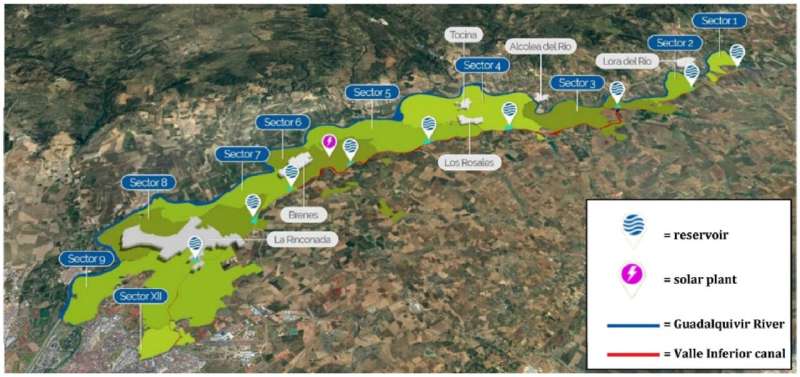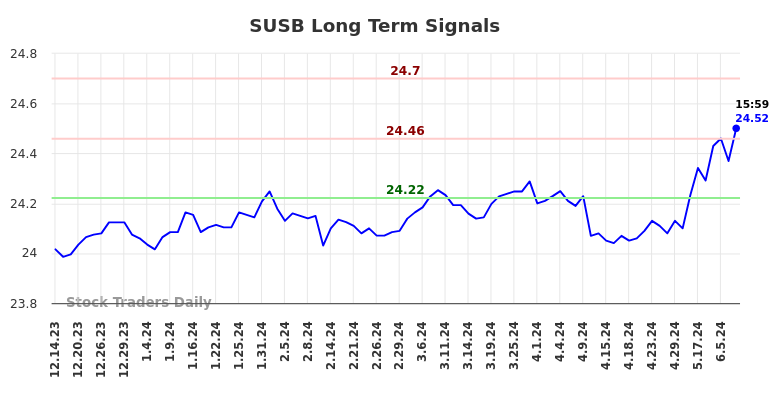

Map of the irrigation system of the Valle Inferior and its division into nine sectors. The solar plant is located in sector 6. Photo credit: Comunidad de Regantes del Valle Inferior, nd
Irrigation is facing the challenge of making its activity more sustainable, both ecologically and economically. In this context, energy self-sufficiency is proposed as a path for agriculture in the future.
The irrigation community in the Lower Guadalquivir Valley, which covers almost 19,000 hectares and has more than 2,000 irrigation systems, began solar self-sufficiency in 2019 through the installation of a 6-megawatt photovoltaic system, the largest of any irrigation system in Spain, making it a pioneer and testing ground for the scientific community as it stimulates efforts to transition to an environmentally and economically sustainable irrigation model.
The most recent example is the close collaboration with the Hydraulics and Irrigation Research Group of the María de Maeztu Unit of Excellence in conjunction with the Faculty of Agricultural Sciences of the University of Córdoba (DAUCO). Together, different strategies have been proposed to maximize the use of self-generated solar energy, prevent the loss of surpluses and reduce dependence on external energy sources.
Researchers Maaike van de Loo, Emilio Camacho and Juan Antonio Rodríguez, who led the study, explain that currently more solar energy is produced than consumed, creating a surplus of about 50%. At the same time, a secondary source is needed to meet energy needs when solar energy is not produced, for example at night.
To solve this situation, two possible solutions were studied that would help reduce energy loss and optimize its use. The ideas were published in the journal Renewable energy.
The first proposes a change in farmers’ habits. They should adjust irrigation schedules to coincide with the hours of the day when solar energy is generated and avoid nighttime irrigation. This approach, the research team explains, represents a paradigm shift, as the Lower Valley community had traditionally opted for nighttime irrigation due to the benefits it brings: cheaper energy prices and milder temperatures that reduce water evaporation.
However, the reduction in energy costs achieved by the construction of the photovoltaic system and the spread of drip irrigation, which reduces water consumption by up to 60% compared to other conventional methods (as it allows more precise application and therefore fewer losses), are giving irrigators reason to change their practices.
The strategy proposed by the research group is to abandon on-demand irrigation (water availability around the clock) and concentrate its use on 8 to 12 hours of sunshine. This would significantly increase the availability of photovoltaic energy to over 90%.
The researchers clarify that even if this model is implemented, an additional energy source to complement solar energy would always be required due to the dependence on weather and environmental conditions. However, in a region such as Andalusia, with more than 3,000 hours of sunshine per year, the strategy would significantly reduce dependence on external sources and contribute to a more sustainable irrigation model, both economically and environmentally.
The second scenario is economic in nature and involves selling excess energy, which is what the Lower Valley Community has been doing since the plant was installed. However, an increase in solar energy production at national and European level has led to lower prices, reducing profitability.
The study concludes that there is currently no solution that guarantees 100% use of solar energy, despite it being a valuable resource. Nevertheless, the researchers are confident that research such as this, together with the experience of the Lower Valley Irrigation Community, can pave the way for irrigation of the future, irrigation that combines environmental protection with economic profitability and fully exploits the potential of the area.
More information:
Maaike van de Loo et al., Defining the optimization strategy for the use of solar energy in large water distribution networks: A case study of the Valle Inferior irrigation system, Spain, Renewable energy (2024). DOI: 10.1016/j.renene.2024.120610
Provided by the University of Córdoba
Quote: From daytime irrigation to selling surplus energy: optimizing solar energy use in irrigation communities (July 3, 2024), accessed July 4, 2024 from https://techxplore.com/news/2024-07-daytime-irrigation-surplus-energy-optimizing.html
This document is subject to copyright. Except for the purposes of private study or research, no part of it may be reproduced without written permission. The contents are for information purposes only.



